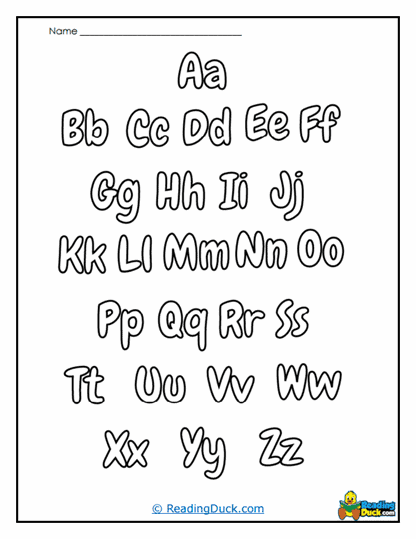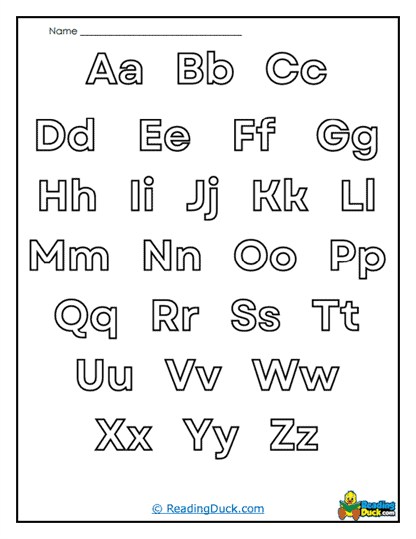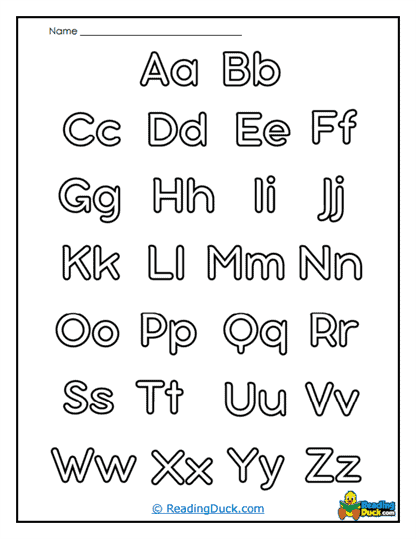Bubble Alphabet Worksheets
About Our Bubble Letters of the Alphabet Worksheets
This selection of worksheets was designed to introduce young learners to the alphabet in a fun, hands-on way. Each worksheet presents letters in a large, outlined “bubble” style that students can fill with color, trace, and outline, combining playful coloring with purposeful letter recognition. This format transforms learning into an interactive experience, where students are not only familiarizing themselves with letter shapes but are also engaging their creativity in an activity that feels more like play than a traditional writing exercise. By incorporating these worksheets, teachers can introduce the alphabet in an inviting, low-pressure way that keeps students interested and excited about handwriting practice.
The primary purpose of these Bubble Letters Worksheets is to build foundational motor skills and increase familiarity with letters, making early handwriting practice both approachable and enjoyable. This is especially important for younger or beginner writers who are developing fine motor skills, and the “bubble” format allows them to explore letters through broad, forgiving shapes that build their confidence. Students begin by visually observing and mentally processing each letter’s shape, then practice hand movements that strengthen motor skills. By coloring and tracing each bubble letter, they start making visual-motor connections that are essential for forming letters smoothly and confidently, creating a strong base for future writing tasks. For teachers, this makes it possible to support both cognitive and physical development with an activity students enjoy, while gently introducing skills that will be vital as they progress to writing independently.
These worksheets are popular among teachers and parents alike because they bridge the gap between basic coloring activities and the more advanced, coordinated movements needed for proper writing. They engage young learners, who often perceive them as a coloring activity rather than a structured lesson, making the learning process both enjoyable and highly productive. For teachers, bubble letter worksheets offer a versatile tool: they can be incorporated into individual learning sessions, group activities, or even quiet time, allowing teachers to reinforce letter recognition and early writing skills across different classroom settings. By making letter learning feel like play, these worksheets turn handwriting practice into a rewarding experience for students, setting the stage for a positive attitude toward literacy that can last a lifetime.
How to Use These Worksheets
Step 1: Recognizing and Identifying Letter Shapes
The first step involves recognizing each letter's shape. By seeing each letter in its bubble form, students begin to familiarize themselves with the unique contours of each letter, helping them distinguish one letter from another. This visual recognition helps students build an intuitive understanding of letter forms, preparing them for reading by solidifying the visual foundation of each character. As they interact with the letters, students start to notice distinct characteristics, like the roundness of 'O' versus the angles in 'A,' which further reinforces memory and identification skills. This activity, as the foundation of letter recognition, is essential for reading and writing, creating a solid base that will make decoding words and eventually writing them much easier.
Step 2: Tracing and Coloring Inside the Lines
Next, students trace the outline and fill each letter with color. This step helps them learn spatial awareness—staying within the lines enhances hand-eye coordination, and practicing control helps them begin to build the small motor movements necessary for handwriting. The act of tracing also promotes concentration, as students must focus on guiding their pencil around each curve and line, which reinforces their visual and motor connection. Coloring within the bubble letters encourages patience and accuracy, qualities that support neat and controlled handwriting as they progress. As they focus on tracing and filling each letter, students develop muscle memory, a key aspect of forming letters smoothly when they start writing on their own, providing a strong foundation for clear and legible writing.
Step 3: Repetition and Familiarity with Letter Forms
Finally, repeated practice on different letters allows students to grow comfortable with letter shapes, preparing them for independent writing. By working with bubble letters, students develop an understanding of letter forms in a way that feels low-pressure, but that gradually builds toward their future ability to write letters clearly and confidently. Each repetition reinforces their ability to recall and replicate the letters, helping to improve speed and accuracy over time. This familiarity provides a sense of mastery and reduces hesitation, which is important when they begin combining letters to form words. Ultimately, this repetition not only boosts confidence but also encourages a natural, flowing writing style as they develop stronger control and familiarity with each letter.
Each phase-recognition, tracing, and familiarization-serves to strengthen core skills needed in handwriting, from improved coordination to understanding letter shapes and proportions. By working with bubble letters, students also develop a positive association with learning letters, making it more likely they'll approach handwriting with confidence.
Benefits of These Worksheets
Building Fine Motor Skills
One of the primary benefits of using Bubble Letters Worksheets is the development of fine motor skills. Coloring within the outlined letters demands precision and control, strengthening the small muscles in a child's hands and fingers. These worksheets offer an enjoyable way to build these essential skills, as children often see the activity as play rather than structured practice. Over time, these strengthened muscles translate to improved dexterity, making it easier for students to transition to writing smaller, more intricate letters.
Enhancing Hand-Eye Coordination
As students work to stay within the lines while coloring, they build hand-eye coordination. This skill, although seemingly simple, is foundational in learning to write, as it allows students to maintain control over their pencil or pen. By practicing with bubble letters, children learn to synchronize their visual input with physical movements, a skill that enhances not just handwriting but other activities requiring precision. This gentle approach to developing coordination fosters a sense of accomplishment, reinforcing their confidence in using writing tools effectively.
Promoting Letter Recognition and Familiarity
By interacting with each letter in a playful format, students begin to recognize and memorize letter shapes. Recognizing each letter is a vital step in early literacy, as it helps students connect visual recognition with verbal language. Bubble letters provide an enjoyable, low-pressure introduction to letter forms, making it easier for children to retain and recall them. This playful repetition solidifies letter recognition, laying a strong foundation for future literacy skills, from reading to spelling.
Supporting Cognitive Engagement with Letters
As students focus on each letter’s shape, they mentally process its contours, angles, and structure. This repeated mental engagement with letters helps create a strong cognitive link, making it easier for students to recall letter shapes and write them from memory. Bubble letters encourage a natural, immersive way to build these connections, making the learning process feel less like a task and more like a creative activity. This gentle approach to cognitive engagement fosters a relaxed environment, allowing children to process and internalize each letter’s form.
Building Writing Stamina and Confidence
The act of coloring and tracing also builds writing stamina. Since young students may find long writing sessions tiring, bubble letters allow them to practice letter formation without feeling overwhelmed. By gradually building endurance, students become accustomed to longer writing tasks, making transitions to formal writing smoother. This steady increase in stamina, combined with the positive reinforcement of completing each letter, helps students approach writing tasks with greater confidence and enthusiasm.
A Unique Approach to Handwriting Practice
Compared to traditional worksheets, bubble letters provide a different sensory and creative experience. The playful nature of coloring and tracing makes these worksheets appealing, turning what might feel like a chore into a fun activity. This enjoyable approach not only makes children more likely to engage regularly but also fosters a positive association with handwriting. Bubble Letters Worksheets offer a creative, stress-free introduction to handwriting, making them a go-to resource for educators and parents aiming to nurture both skill and confidence in young learners.
Tips for Educators and Parents
1. Start with a Few Letters and Gradually Build Up
Introduce a few bubble letters at a time rather than overwhelming students with the entire alphabet. This gradual approach allows children to become comfortable with each letter before moving on, giving them the time to master one skill before advancing. By focusing on just a few letters, students can experience a sense of accomplishment sooner, which keeps them motivated to continue. This approach also allows educators and parents to provide targeted support and feedback on specific letters, making each learning moment more impactful.
2. Make It a Game
Turning handwriting practice into a game can significantly increase a child's interest. For instance, set up a challenge where each correctly colored letter earns a "point," and after a certain number of points, students can enjoy a small reward or treat. Gamifying the process turns learning into a fun, goal-oriented activity, making students eager to participate. This playful approach also helps to build positive associations with handwriting practice, which can foster a lifelong love for learning.
3. Combine with Phonics Practice
Use each letter's bubble outline to reinforce phonics skills. After coloring a letter, have students say the letter's sound out loud, connect it to words that start with the same sound, or even draw pictures of things that begin with that letter. This multi-sensory approach not only strengthens handwriting but also improves phonetic awareness, supporting early reading skills. Integrating phonics with handwriting gives students a more comprehensive language experience, helping them connect the dots between sounds, letters, and words.
4. Regular but Short Sessions
Keep sessions short to maintain enthusiasm, especially for younger learners who may not have long attention spans. Short, daily practice-around 5-10 minutes per session-help build a habit without overwhelming them. This bite-sized approach makes handwriting practice a daily routine, allowing skills to develop naturally over time. Plus, consistent, brief sessions prevent burnout and keep students coming back for more without feeling fatigued or frustrated.
5. Celebrate Progress and Effort
Encouragement goes a long way! Praise students not only for "staying within the lines" but also for their effort, patience, and focus. Celebrating each small victory, whether it's improved coordination or mastering a tricky letter, boosts self-esteem and motivation. This positive reinforcement not only keeps students engaged but also builds resilience, teaching them that effort and practice lead to growth.
6. Incorporate Group Activities or Buddy Systems
If possible, let children work on their bubble letters with a friend or sibling. Working together can make the activity more enjoyable and allows children to learn from each other. Collaboration creates a supportive environment where children feel inspired to practice alongside their peers. A buddy system also introduces accountability, as kids often stay more focused and motivated when they see others doing the same activity.









